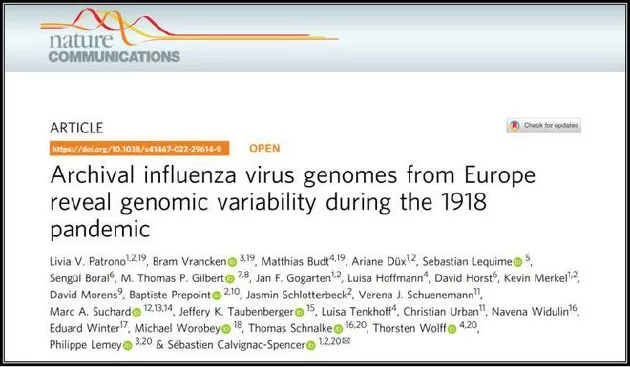A study published in the British journal Nature communications on the 10th found that the seasonal H1N1 influenza virus may be the "direct offspring" of the 1918 influenza strain that caused the global influenza pandemic The results came from genomic analysis of European samples during the 1918 pandemic.
It is estimated that the 1918 pandemic killed 50 million to 100 million people worldwide. People's understanding of the spread and timing of the pandemic is based on historical data and medical records, which show that the pandemic peaked in the autumn of 1918 and lasted until the winter of 1919. However, it was not until the 1930s that it was confirmed that the source was viral infection. After that, studies showed that the culprit was the H1N1 subtype of influenza A virus. Due to the very few virus sequences left at that time, it has been difficult to carry out genome analysis of the 1918 virus.

Scientists at the Robert Koch Institute in Germany analyzed 13 lung samples collected in the historical archives of German and Austrian museums. These samples were collected from different individuals from 1901 to 1931, of which 6 samples were collected from 1918 and 1919. Through these samples, they were able to sequence two incomplete genomes collected in Berlin in June 1918 and a complete genome collected in Munich in 1918.
The researchers believe that the genomic diversity of these samples is consistent with the combination of local transmission and long-distance diffusion. By comparing the genomes before and after the peak of pandemic influenza, they found differences in nucleoprotein genes, which are related to the resistance of antiviral response and may have helped the virus adapt to the human body.
The team also conducted molecular clock modeling, which can be used to estimate the time scale of evolution. They found that all genomic fragments of the seasonal H1N1 influenza virus may be "direct descendants" of the initial strain of the 1918 pandemic. This refutes other hypotheses that the seasonal virus comes from gene recombination (the genomic fragments of different viruses are exchanged).
The researchers stressed that their sample size was still extremely limited, but the study gave people a better understanding of the evolution and development of the 1918 influenza pandemic, which also reflected the valuable value of consulting historical archives.